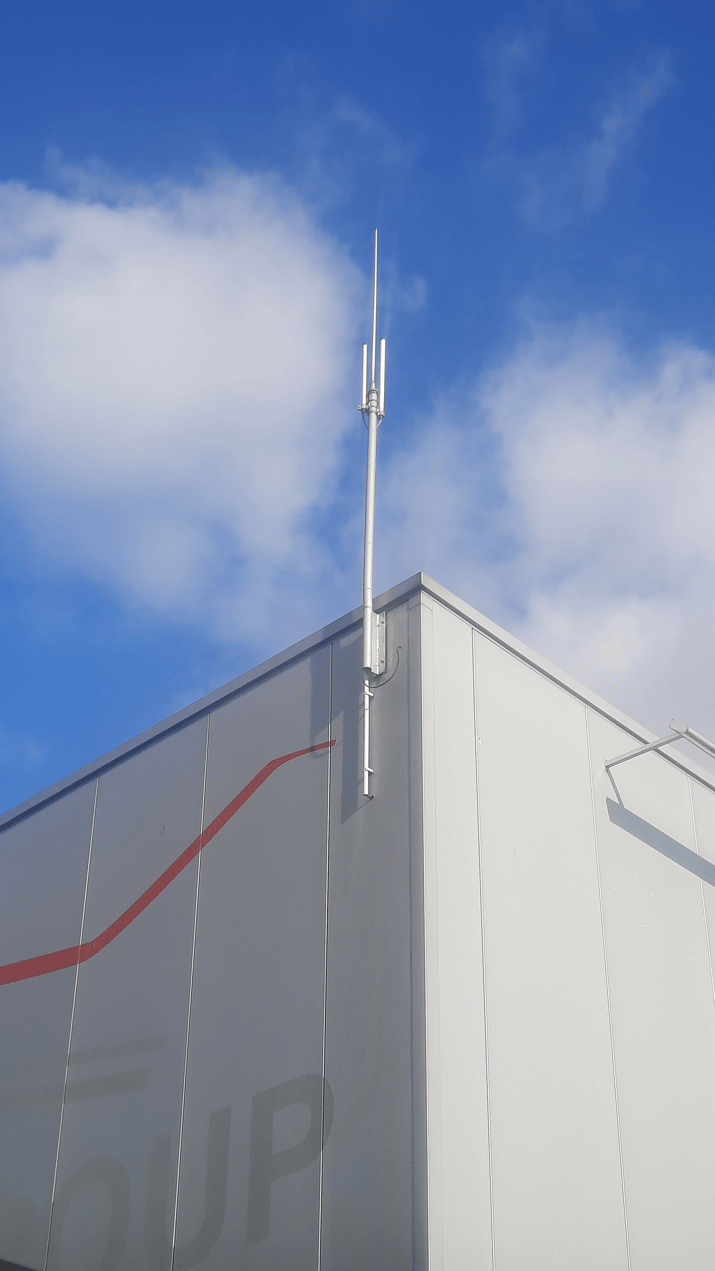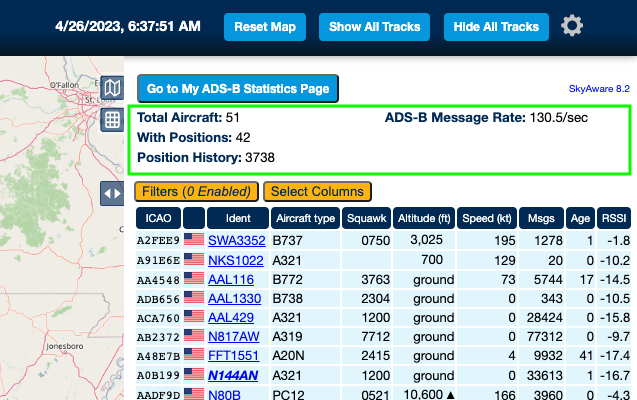See the latest from the FlightAware ADS-B Network, a community of aviation enthusiasts hosting a network of over 34,000 receivers in almost 200 countries and on all seven continents. If you're interested in joining or adding to our network, check out the ADS-B store.
May 2023 Highlights:
- April Stats Recap
- Featured Receiver Sites
- Optimizing Your Receiver for Reliability and Performance: Signal Amplifiers and Filters
If it's your first time here, enter your email below to receive monthly newsletters from the ADS-B team at FlightAware. We'll be sharing news, updates, and helpful information about all things ADS-B!
Last Month
- We had 244 new users join our terrestrial ADS-B network.
- We shipped FlightFeeders to the Emirates, Australia, Belgium, Bolivia, Canada, Germany, India, Mauritius, New Zealand, Paraguay, Peru, the Philippines, and the United States.
- We talked with various airlines and airports that are interested in installing FlightFeeders around their locations to enhance the quality of FlightAware data they use to power their operations.
Featured Sites for May


These photos were sent to us by FlyingGroup (FYG002) located in Antwerp, Belgium. They are an operator of a fleet of private jets and host a PiAware at their aircraft hangar at Antwerp International Airport. Pictured above is a photo of their Operations Control Center where they utilize FlightAware TV to help them monitor their fleet of aircraft.


This fully-DIY ADS-B receiver was sent to us by steamer2010. His “Max Max” style setup, as he describes it, uses a wide-range USB tuner and has indicators showing input voltage, Raspberry Pi voltage, and Raspberry Pi current. The antenna was made using PVC water pipe and coaxial TV cable. He’s been a contributor to FlightAware with an impressive streak of 1300+ days and counting!
This is a great example of the cool things you can do when you build a custom ADS-B receiver.
Proud of your receiver setup? Submit your photos!
Each month we will proudly feature some of our ADS-B receivers hosts in our newsletter and across our social accounts. If you’re interested in being featured, please submit photos of your setups and a small summary about you or your setup, and we’ll pick some of the best ones to feature each month!
Optimizing Your Receiver for Reliability and Performance
If you missed our previous newsletters where we discuss the topics checked below, you can find them in our FlightAware blog.
Checklist for Optimal Receiver Setup
✅ Power
✅ Antennas
✅ Cables
⬜ Signal Amplifiers and Filters
⬜ Internet Connection
⬜ Lightning and Electrical Surge Protection
This month, we’ll be talking about signal amplifiers and filters and how they are used to improve ADS-B signal reception and receivable range of an ADS-B receiver.
What is a signal amplifier?
A signal amplifier is an electronic device that increases the power of a signal at its input. ADS-B signals transmitted from aircraft can often be degraded due to factors like signal interference, physical obstructions, and weather, especially at large distances between the aircraft and the receiver. A signal amplifier can be used to strengthen these weak signals once it reaches the receiver, thus increasing the range in which it can detect aircraft.
However, not only does the signal get amplified, but also the radio frequency (RF) noise present at its input, which can add unwanted distortion to the signal making it more prone to errors when decoding the ADS-B data. For this reason, radio receivers commonly use a special type of amplifier known as a low-noise amplifier (LNA), which is designed to minimize this additional noise.
Do you need an amplifier?
Yes, in the majority of cases, a signal amplifier will improve your ADS-B signal reception and range.
If you use our Pro-Stick or Pro-Stick Plus, there is a built-in SkyWorks 7150 LNA on the radio board so an additional signal amplifier is not needed. Our FlightFeeders come powered with the Pro-Stick.
What is a signal filter?
ADS-B receivers can be subject to noise that can interfere with the ADS-B signals it receives. This noise can be caused by factors such as RF interference from nearby FM radio stations and cell towers and electrical interference from other electronic devices and power lines near the receiver.
Signal filters are electronic devices that are designed to isolate and remove this unwanted noise and sits between the antenna and the radio receiver.
Do you need a signal filter?
It depends. If you live in an environment where there is potential for interference from other radio transmission or electronic devices, then you may benefit from using a signal filter. These places include:
-
Urban areas with high-power radio transmitters such as towers for mobile phones, broadcast radio, or television
-
Airports which have constant radio transmission from air traffic control communications
-
Industrial areas with power lines, transformers, and other industrial equipment
Rural environments and areas with less noise would not need signal filters and can actually hinder your ADS-B signal reception.
Where can I find a signal filter?
FlightAware has built external band pass signal filters specifically designed for 1090 MHz and 978 MHz signals that you can purchase at our FlightAware Store (U.S. only) and other online vendors such as Pi Hut and Moonraker.
Our Pro-Stick Plus includes a built-in 1090 MHz filter that helps with the filtering of noise and is sufficient in most cases. However, your receiver can still benefit from a separate external filter in environments where the noise level is so high that it overwhelms the built-in amplifier.
In summary, signal amplifiers and filters can improve the performance of an ADS-B receiver depending on the hardware and surrounding environment. We encourage you to take some time to research and experiment with and without them to see if you can benefit from it.
To gauge performance improvements, you can monitor your receiver message rate through your local SkyAware interface and your position reports on your My ADS-B Statistics page. You can also compare your receiver statistics to people around you to see if there is room for improvement using the “Nearby Sites” table at the bottom of your My ADS-B stats pages.

Next month, we’ll be talking about Internet Connection.
If you have any topics or content you would be interested in seeing in our monthly newsletter or just want to leave us a comment or feedback, email us at [email protected]
Help increase our coverage!
Our ADS-B network spans across 194 countries on all 7 continents thanks to you all. Our goal is to expand our terrestrial ADS-B coverage across the entire world, especially around airports to improve our surface coverage. If you or someone you know has connections to airports and FBO’s or live in areas where we lack coverage, we’d love to send you a FlightFeeder! You can apply for one here. If we already have coverage in your area, you can still contribute to FlightAware by building your own PiAware. It’s a fun little weekend project!
STAY IN TOUCH
Click the link below to visit the ADS-B Flight Tracking discussion forum on our website, or follow us on social media to stay up to date with the latest news!
 Back to Flight Tracking
Back to Flight Tracking




Join the discussion...
Leave your comment below.